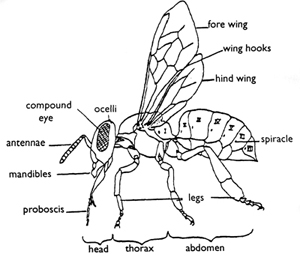Understanding worker bee anatomy can help beekeepers understand bee biology. They are well equipped for life as social animals and to be successful in the environment.

Bees are well covered by branched (plumose) body hairs. They also have thousands of unbranched hairs covering their body which are for sensory purposes. The hairs extend from the body exoskeleton that gives shape and form to a bee. There are no internal bones -bees like all insects have an external skeleton rather than an internal one. The exoskeleton helps protect the delicate internal structures, conserves internal body fluids so the body does not desiccate, and also serves as a protective barrier to the entry of pathogens.
Bees are typical insects in that they have three body regions — head, thorax and abdomen. A pair of antennae extend forward from the head in bees they have a unique shape with an el-bow-like angle so terminal segments bend at a right angle. The head also has conspicuous compound eyes which have a fair degree of visual ability including the detection of colors, movement and distance.

The lower portion of the honey bee head has several structures that combine to make up the mouthparts. Bees have spatula-shaped mandibles to manipulate beeswax and a proboscis, of several parts folded together, to form a straw-like tube to suck up liquids. Tiny antenna-like palpi are loaded with sensory hairs to enable bees to detect numerous sugars, salt, sour and bitter foods.
The middle body portion, the thorax, is made up of three box-like segments with a pair of legs extending from the lower portion of each segment and a pair of wings from the top corner of the second and third segments. Both are features unique to insects. The first pair of legs have antennal cleaning hairs, and the third pair have stiff hairs arranged in rows on the inner portion to comb pollen from body hairs and a special arrangement of long, curved hairs to form a pollen basket on the outer surface. Wings are unequal with larger front wings coupling to smaller hind wings via tiny hooks to give bees exceptional flying ability and agility.

The abdomen appears as a series of similar rings or segments from the outside. Each segment has a pair of openings, spiracles, which are openings into the internal respiratory system. The segments of the abdomen taper to the back where a sting is concealed until used for defense.
Internally the head includes a several part brain and muscles to move mouthpart segments and the antennae. The thorax includes a tube-like esophagus to take food from (and back to) mouthparts, honey stomach and the powerful flight muscles. Most of the digestive tract and the rest of the internal organs are located in the abdomen.
Honey bees have reversible movement of foods from mouthparts to a honey stomach. The honey stomach is a crop or storage area to hold freshly collected nectar (or water) for transport and then deposit inside the nest following regurgitation. Digestion of foods occurs in a mid-gut or ventriculus. The hindgut reclaims water and vital minerals and salts before excretion of only small amounts of undigestible wastes through the anus.

Insects lack arteries and veins and their liquid plasm and blood cells circulate openly within the body cavity (open circulatory system). A tube with muscles (heart) in the abdomen extends forward to the head as the only circulatory structure in an insect. Blood carries food, hormones and cells to fight diseases but does not contain red blood cells holding oxygen. A separate transport system, the tracheal system, carries oxygen-rich air from the exterior to the body cells and gaseous carbon dioxide waste back outside. Spiracles are the openings on the exoskeleton. The body cavity tubes (the trachea) branch repeatedly to smaller tubes (tracheoles) throughout the interior.
Insects also lack kidneys and a liver; thin filamentous projects from the junction of mid and hind gut, termed malpighian tubules, cleanse the blood of nitrogenous cell wastes and deposit them as non-toxic uric acid crystals into the undigestible food wastes for elimination from the anus. There is no liquid waste in bees as their small body size makes water conservation a necessity.
Also, internally a series of nerve cells extend from the brain to concentrations of nerve tissue in each body segment (ganglia) constituting a central nervous system. Bee nerve tissue is not protected within a spinal column — they are in the group of animals termed invertebrate which lack a backbone (vertebrae). Nerves extend from brain and ganglia to send signals to body parts and structures to coordinate behaviors.
Finally, among the muscles and connective tissue inside the body are numerous internal glands. Some deliver their chemicals via the blood inside the body (hormones), other glands produce chemical pheromones and have exterior openings or open into the digestive tract tube. Pheromones and hormones are critical communication chemicals that insure normal body functioning and coordinate individual and social behaviors.
Back to Basic Bee Biology for Beekeepers table of contents
Source:
The above text is taken from The Mid-Atlantic Apiculture Research & Extension Consortium, Basic Bee Biology for Beekeepers; Fact Sheet,MAAREC Publication 1.4 March 2004. You can download this factsheet and others at the MAAREC website
Some images, indicated above, are from Zachary Huang[1]
